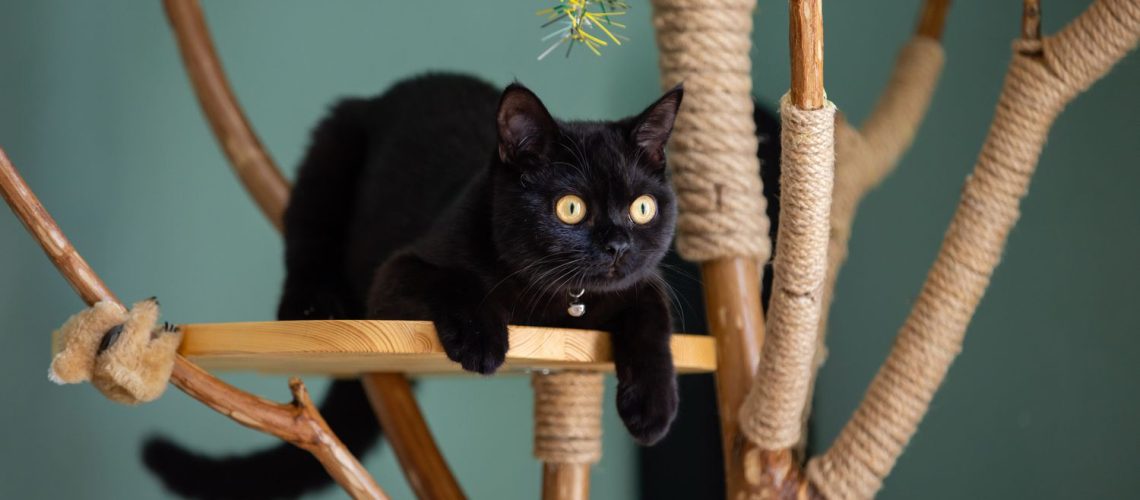Discover how to build your own cat tree with step-by-step DIY plans. Create a customized, cost-effective, and fun environment for your furry friend while strengthening your bond.
Key Takeaways:
- DIY cat tree plans provide a cost-effective alternative to store-bought cat trees.
- Building your own cat tree allows for customization to suit your cat's specific needs and preferences.
- Free DIY cat tree plans can be found online, providing step-by-step instructions and materials lists.
- Cat trees provide valuable vertical space for cats to climb, play, and observe their surroundings.
- Constructing a cat tree can be a fun and rewarding project for both you and your feline friend.
What are DIY cat tree plans?
DIY cat tree plans are step-by-step instructions that guide you in building your own cat tree. A cat tree is a structure designed for cats to climb, scratch, play, and relax. It usually consists of multiple platforms or levels, scratching posts, and various toys or accessories.
With DIY cat tree plans, you can create a customized cat tree that suits your space and your cat's needs. These plans provide detailed measurements, materials lists, and assembly instructions to help you build a sturdy and safe cat tree.
Why build a cat tree yourself?
Building a cat tree yourself can be a fun and rewarding project for both you and your furry friend. Here are a few reasons why you might consider building your own:
- Creative expression: Building your own cat tree allows you to unleash your creativity and design something unique for your cat.
- Cost savings: DIY projects often cost less than buying pre-made items. By building your own cat tree, you can save money while still providing an enriching environment for your pet.
- Bonding with your pet: As you work on the project, you can involve your cat by letting them explore the materials or play with the tools (under supervision). This can strengthen the bond between you and your feline companion.
The benefits of building a cat tree
A well-designed and constructed cat tree offers several benefits for both cats and their owners:
- Environmental enrichment: Cats are natural climbers and need vertical spaces to satisfy their instincts. A cat tree provides opportunities for climbing, jumping, perching, and scratching, which can help keep your cat physically and mentally stimulated.
- Scratching outlet: Cats have a natural need to scratch to maintain healthy claws and mark their territory. A cat tree with built-in scratching posts provides a designated area for your cat to scratch, saving your furniture from damage.
- Personal space: Cats are territorial animals and having their own space can make them feel secure. A cat tree offers elevated platforms where cats can retreat and observe their surroundings from a safe vantage point.
- Reduced stress: Providing vertical spaces for your cat can help reduce stress by giving them more opportunities to escape from other pets or children, providing a sense of security.
Materials needed for constructing a cat tree
To build a basic cat tree, you will need the following materials:
- Plywood or particle board for the base and platforms
- Sisal rope or carpet for wrapping the scratching posts
- Screws or nails for assembly
- Wood glue (optional)
- Foam padding or fabric for cushioning the platforms (optional)
- Toys or accessories to attach to the cat tree (optional)
You may also need tools such as a saw, drill, screwdriver, measuring tape, and staple gun. The specific materials required may vary depending on the design of the cat tree you choose to build.
Why build a cat tree yourself?
Building a cat tree yourself can be a rewarding and cost-effective option for cat owners. By constructing your own cat tree, you have the freedom to customize it according to your cat's preferences and your home decor. Additionally, building a cat tree can be a fun DIY project that allows you to unleash your creativity and woodworking skills. It also provides an opportunity for bonding with your feline friend as you involve them in the process of building their own special space.
Save Money
One of the main benefits of building a cat tree yourself is the potential cost savings. Purchasing a pre-made cat tree from pet stores or online retailers can be quite expensive, especially if you're looking for high-quality and durable options. By sourcing materials and constructing the cat tree on your own, you can significantly reduce costs while ensuring that it meets your specific requirements.
Customization
When you build a cat tree yourself, you have complete control over its design and features. You can tailor it to suit your cat's size, age, and activity level. For example, if you have multiple cats or kittens, you can include multiple platforms or hiding spots to accommodate all of them. You can also incorporate scratching posts at different heights or add interactive toys to keep your furry friends entertained.
Benefits for Your Cat
Building a custom cat tree allows you to create an environment that promotes physical exercise and mental stimulation for your feline companion. Cats love climbing, scratching, perching, and observing their surroundings from elevated positions. A well-designed homemade cat tree can provide all these opportunities in one place, keeping your cats engaged and happy.
Overall, building a cat tree yourself offers financial savings, customization options, and the chance to create an enriching environment tailored specifically for your beloved feline friends.
The benefits of building a cat tree
Building a cat tree can provide numerous benefits for both you and your feline friend. Firstly, having a cat tree allows your cat to indulge in their natural instinct to climb and perch. This helps them exercise and stay active, which is essential for their overall health and well-being. Additionally, a cat tree provides vertical space for your cat to claim as their territory, reducing the likelihood of them scratching furniture or other household items.
Furthermore, a cat tree can serve as a dedicated space for your cat to relax and nap. Many cat trees come with cozy platforms or enclosed spaces where cats can feel safe and secure. This can be particularly beneficial if you have multiple cats in your household, as it gives each of them their own personal space.
Benefits at a glance:
- Provides exercise and stimulation for cats
- Reduces destructive behavior like scratching furniture
- Gives cats their own territory
- Offers a dedicated space for relaxation and napping
- Suitable for households with multiple cats
Improved well-being:
Cat trees contribute to the overall well-being of your pet by providing them with opportunities to engage in natural behaviors such as climbing, perching, and scratching. These activities help keep cats mentally stimulated and physically active, preventing boredom and potential health issues associated with sedentary lifestyles.
Materials needed for constructing a cat tree
To build a basic cat tree, you will need several materials that are easily accessible. The specific materials may vary depending on the design you choose, but here are some common ones:
Main materials:
- Wooden boards or plywood for the base and platforms
- Sisal rope or carpet for scratching surfaces
- Sturdy posts or PVC pipes for vertical supports
- Foam padding or cushions for comfort
- Staple gun or nails to secure materials together
- Optional: fabric or upholstery for covering the platforms
Tips:
When choosing materials, make sure they are safe and non-toxic for your cat. Avoid using toxic adhesives, paints, or finishes that could harm your pet if ingested. It's also important to select materials that can withstand your cat's weight and activity level.
Step-by-step guide to building a basic cat tree
Gather materials and tools
To start building a basic cat tree, you will need the following materials: plywood, carpet or sisal rope, screws, brackets, and a sturdy base. Additionally, you will need tools such as a saw, drill, staple gun, and measuring tape. Make sure to gather all the necessary materials and tools before beginning the construction process.
Measure and cut the plywood
Start by measuring and cutting the plywood into desired sizes for each level of the cat tree. You can create different platforms at various heights to provide your cat with options for climbing and perching. Use a saw to carefully cut the plywood according to your measurements.
Assemble the base
Next, assemble the base of the cat tree using the cut pieces of plywood. Attach them together using screws and brackets for added stability. Ensure that the base is sturdy enough to support multiple levels and withstand your cat's weight.
Cover with carpet or sisal rope
Once the base is assembled, cover it with carpet or sisal rope to provide traction for your cat while climbing. Use a staple gun to secure the material tightly around each platform. This will also serve as scratching surfaces for your feline friend.
Tips:
- Consider adding additional features such as scratching posts or dangling toys to make the cat tree more engaging for your pet.
- Make sure all edges are smooth and free from any sharp points that could potentially harm your cat.
- Place the finished cat tree in an area where your furry friend can easily access it without any obstructions.
Overall, building a basic cat tree requires careful planning, precise measurements, and attention to detail. By following these steps and incorporating your own creative ideas, you can create a safe and enjoyable space for your cat to climb, play, and relax.
Safety tips for constructing a cat tree
Choose sturdy materials
When constructing a cat tree, it is essential to choose sturdy materials that can withstand your cat's weight and movements. Opt for high-quality plywood or solid wood for the platforms and posts. Avoid using flimsy materials that may break or collapse under pressure.
Secure all components properly
Ensure that all components of the cat tree are securely fastened together. Use screws, brackets, or strong adhesive to reinforce the connections between platforms, posts, and other parts. This will prevent any wobbling or instability that could potentially cause accidents.
Check for sharp edges or protruding nails
Before allowing your cat to use the newly constructed cat tree, carefully inspect it for any sharp edges or protruding nails. Sand down any rough edges and make sure all nails or screws are properly countersunk to avoid injury to your pet.
Tips:
- Regularly inspect the cat tree for signs of wear and tear. Replace any worn-out carpeting or sisal rope promptly.
- Place the cat tree away from windows or other areas where it could be knocked over by strong gusts of wind.
- Supervise your cat initially while they explore the new cat tree to ensure their safety.
By following these safety tips, you can create a secure environment for your feline companion to enjoy their new cat tree without any risks of accidents or injuries.
Time required to build a cat tree
Building a basic cat tree typically takes around 4-6 hours, depending on your level of experience and the complexity of the design. This estimate includes gathering materials, measuring and cutting plywood, assembling the base and platforms, covering with carpet or sisal rope, and ensuring the stability of the structure.
However, it's important to note that the time required may vary based on individual factors such as your familiarity with tools and construction techniques. Beginners may take longer to complete the project compared to those with prior experience in woodworking or DIY projects.
To save time, consider using pre-cut plywood or purchasing a cat tree kit that includes all the necessary materials and instructions. This can significantly reduce the construction time and make the process more efficient.
Tips for beginners building a cat tree
Start with a simple design
For beginners, it is recommended to start with a simple cat tree design that doesn't involve complex structures or intricate details. This will allow you to familiarize yourself with the basic construction process before attempting more advanced designs.
Follow detailed instructions or tutorials
To ensure success in building your first cat tree, follow detailed instructions or tutorials specifically designed for beginners. These resources often provide step-by-step guidance, along with helpful tips and tricks to make the process easier.
Take safety precautions
Prioritize safety throughout the construction process by wearing protective gear such as gloves and safety goggles. Additionally, ensure that all tools are used correctly and safely. If you're unsure about any step or technique, seek guidance from experienced individuals or professionals.
Tips:
- Don't be afraid to ask for help if needed. Having an extra pair of hands can make certain steps easier.
- Take breaks when necessary to avoid fatigue or rushing through the project.
- Enjoy the process and have fun while building your cat tree!
Remember, practice makes perfect. As you gain more experience and confidence in building cat trees, you can gradually explore more complex designs and incorporate additional features to create unique and personalized structures for your furry friend.
Where to find 8 free DIY cat tree plans online
1. The Spruce Pets
The Spruce Pets website offers a variety of free DIY cat tree plans, ranging from simple designs to more elaborate structures. They provide detailed instructions, material lists, and step-by-step photos to guide you through the construction process.
2. Instructables
Instructables is a platform where users share their DIY projects, including cat tree plans. You can find a wide range of designs with varying levels of difficulty. Each plan includes detailed instructions, photos, and sometimes even videos to help you along the way.
3. DIY Network
DIY Network provides free cat tree plans that cater to different skill levels. Their plans come with clear instructions and diagrams to assist you in building your own cat tree. They also offer tips on customizing the design to suit your preferences.
4. Ana White
Ana White's website features free cat tree plans that are beginner-friendly and budget-conscious. Her plans include detailed measurements, cut lists, and step-by-step instructions accompanied by diagrams for easy understanding.
5. Meow-Cat.com
Meow-Cat.com offers a collection of free DIY cat tree plans suitable for various skill levels. Their plans include detailed drawings, material lists, and assembly instructions to guide you through the construction process.
6. Purrfect Cat Breeds
Purrfect Cat Breeds provides free cat tree plans specifically designed for beginners. Their plans feature simple designs with easy-to-follow instructions and illustrations.
7. CatsPlay.com
CatsPlay.com offers free downloadable PDFs of their cat tree plans. These plans include step-by-step instructions along with helpful tips and suggestions for customization.
8. Pinterest
Pinterest is a great platform to find a wide range of free cat tree plans shared by DIY enthusiasts. Simply search for "free DIY cat tree plans" and explore the numerous options available. Many plans include links to external websites or blogs with detailed instructions.
With these online resources, you can access a variety of free cat tree plans that suit your skill level and preferences. Take advantage of the step-by-step instructions and helpful tips provided to successfully build your own cat tree without breaking the bank.
| Conclusion | |
| After exploring these 8 free DIY cat tree plans, you have all the inspiration and guidance you need to create a fun and engaging space for your feline friend. Whether you're looking for a simple design or a more elaborate structure, there's something here for every skill level. So grab your tools, get creative, and watch your cat enjoy their new favorite spot! | Remember to prioritize safety while building the cat tree, ensuring stability and using pet-friendly materials. Additionally, customize the designs to suit your cat's preferences and provide plenty of opportunities for climbing, scratching, and resting. |
What fabric to use for cat tree?
Sisal rope is commonly used to cover cat scratching posts, but sisal fabric is actually a superior choice. When a cat scratches at the rope, its fibers become loose and sharp, which makes the cat less likely to use the post. On the other hand, sisal fabric becomes softer as it is scratched, which encourages increased usage by the cat.
Are cat trees hard to build?
Creating a simple and affordable cat tree is a straightforward task. Begin by determining the desired location for the DIY cat tree to determine its size. Look for plans and browse through various cat tree towers, condos, and other cat furniture for inspiration on how to construct the cat tree.
What wood is safe for cats?
Cedar is a great type of wood to use for outdoor cat enclosures because it has a pleasant smell, is flexible, long-lasting, and environmentally friendly.
What size should a cat tree be?
The recommended height for a cat tree is similar to, or taller than, your kitchen counter and shelves. This height will discourage your cat from climbing on your furniture and encourage them to perch on the tree instead. It should also be higher than your sofa and tables.
What fabric is hard for cats to scratch?
Microfiber or microsuede couches are a great choice for cat owners who are on a budget. These fabrics are less expensive than leather and are made with tightly woven threads that are difficult for cats to scratch into.
What kind of wood do cats like to scratch?
There are a limited number of cat trees made entirely of wood, like this one. These types of cat trees are great for cats that like to scratch on wood surfaces, especially if they are targeting your stairway banister. Cedarwood is a popular choice because it provides a surface that cats can both see and smell their paw-marks on. Additionally, cedarwood has a pleasant scent.

















